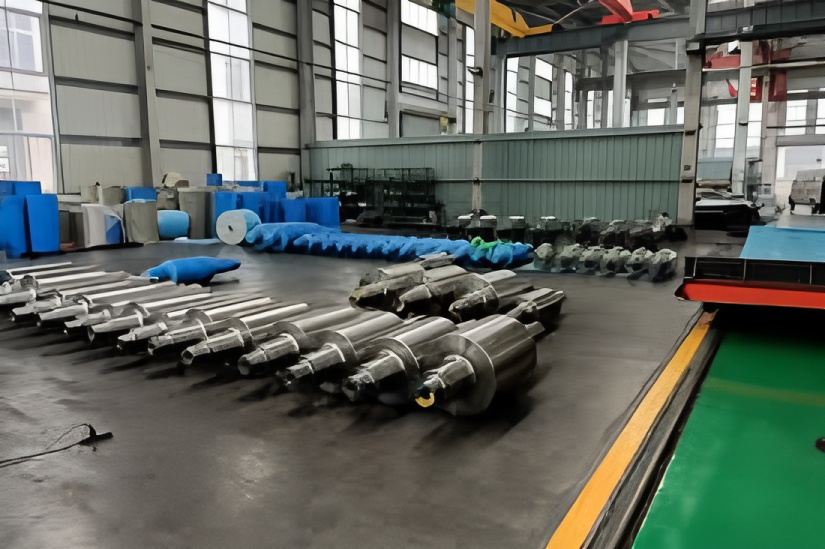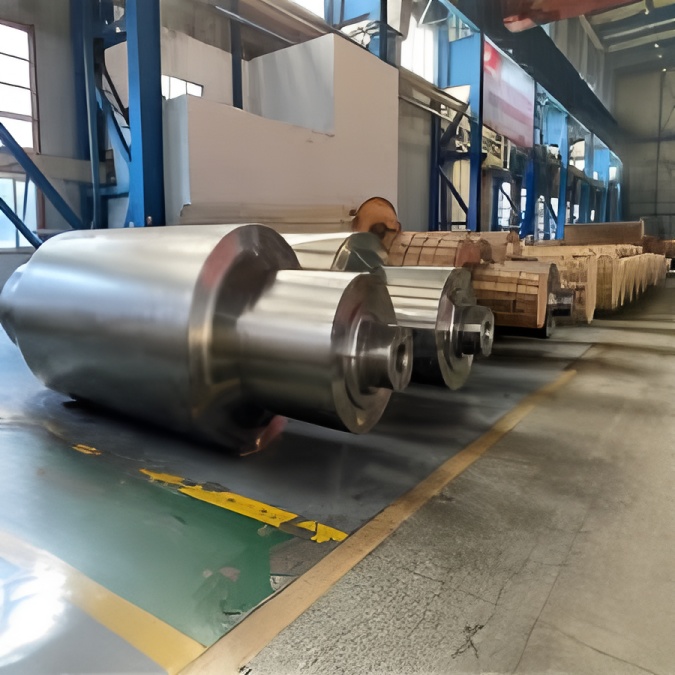Classification of Rolling Mill Rolls
Rolls can be categorized in various ways, but the following three classification methods are commonly adopted:
By Application:
Primary Rolls:
Slab bloom rolls
Billet bloom rolls
(Note: Usage of these rolls has decreased with increased adoption of continuous casting.)
Strip Rolls:
Heavy plate rolls
Thin plate rolls
Hot-rolled strip rolls
Narrow strip rolls
Cold-rolled strip rolls
Section Rolls:
Large section rolls
Medium and small section rolls
Bar rolls
Wire rods rolls
Steel tube rolls
By Material:
Cast Iron Rolls:
Chill cast iron rolls
Indefinite chill cast iron rolls
Semi-chill cast iron rolls
Nodular cast iron rolls
High chromium cast iron rolls
Cast Steel Rolls:
Alloy cast steel rolls
Alloy semi-steel rolls
Graphite steel rolls
High chromium steel rolls
High-speed steel rolls
Forged Steel Rolls:
Alloy forged steel rolls
High chromium forged steel rolls
Forged high-speed steel rolls
Special Rolls:
Tungsten carbide rolls
Ceramic composite rolls
By Weight:
Large rolls: > 10 tons
Medium rolls: 3–10 tons
Small rolls: < 3 tons

Selection of Rolling Mill Roll Materials
Rolls are critical consumable tools in steel rolling. Their performance directly affects the dimensional accuracy and surface quality of rolled products. Proper roll design and material selection must align with specific mill conditions and product requirements.
Blooming Mill Rolls
Blooming mills process steel ingots with coarse dendritic structures prone to segregation. High rolling temperatures and heavy reductions refine the grain structure. Rolls must exhibit excellent thermal crack resistance and strength.
Historically, forged or cast steel rolls were used for their strength but lacked wear resistance.
Since 1958, nodular cast iron rolls (43–48 HSD) have been successfully applied, offering a good balance of wear and thermal crack resistance, though they may be prone to slipping. Proper heat treatment ensures sufficient strength.
Plate Mill Rolls
Plate mills include two-high reversible, three-high Lauth, and four-high reversible types.
Lauth Mills: The middle roll acts as the work roll. Low/medium Ni-Cr-Mo indefinite chill iron rolls (60–70 HSD) are used for wear and thermal fatigue resistance.
Four-High Reversible Mills: Backup rolls are typically cast steel (45–52 HSD). Work rolls have evolved to high-alloy indefinite chill iron (75–82 HSD), with modern versions offering improved graphite and carbide morphology. Leveling rolls use centrifugal composite high-alloy indefinite chill iron (70–80 HSD).
Stacked Thin Plate Rolls
Though mostly phased out globally, some mills in China still use these. Characteristics include:
Non-reversible cyclic rolling;
Frequent re-heating due to rapid cooling;
Multi-sheet stacking for thickness < 2 mm;
High roll temperatures (500–600°C), no water cooling;
High rolling pressure (900–1600 tons).
Rolls require high thermal conductivity, spalling and impact resistance. Low-alloy Cr-Mo indefinite chill nodular iron (57–63 HSD) is typically used. Breakage and spalling are common issues.
Hot Strip Mill Rolls
Hot strip mills include semi-continuous, 3/4 continuous, full continuous, and thin-slab continuous types.
Roughing Stands: Require high torsional and bending strength, thermal crack resistance. Common materials: alloy cast steel (43–50 HSD) or high-strength nodular iron (55–60 HSD). Graphite steel composite rolls are also used.
Finishing Stands (F1–F7):
Backup Rolls: Cast or forged steel (40–70 HSD) with high fatigue strength.
Work Rolls – Front Stands (F1–F3): High-chromium iron (70–80 HSD) or high-speed steel (HSS) for improved life and resistance to sticking.
Work Rolls – Rear Stands (F4–F7): High-Ni-Cr-Mo indefinite chill iron (75–85 HSD) for wear resistance. HSS rolls (80–90 HSD) are increasingly used for longer service life.
Leveling Rolls: Centrifugal composite indefinite chill iron (70–80 HSD).
Hot-Rolled Narrow Strip Rolls
For strip width < 500 mm, roll selection is similar to hot strip mills:
Roughing: alloy cast steel (40–50 HSD) or nodular iron (45–55 HSD);
Finishing Front: bainitic nodular iron (60–70 HSD) or medium-high alloy indefinite chill iron;
Finishing Rear: high-alloy indefinite chill iron (75–85 HSD) or HSS (80–90 HSD);
Backup Rolls: semi-steel.
Cold Strip Mill Rolls
Cold rolling uses emulsions for lubrication and cooling. Work rolls are typically forged steel (80–95 HSD). Some mills use high-alloy indefinite chill iron (75–80 HSD), though graphite can cause surface staining. Semi-HSS and high-chromium forged steel are emerging alternatives.
Large Section Mill Rolls
Stands include roughing, intermediate, and finishing.
Roughing: Deep grooves, high loads → alloy cast steel or graphite steel. Alloy semi-steel (45–50 HSD) is also used with improved cooling.
Intermediate: Thermal crack and wear resistance → alloy nodular iron (50–60 HSD).
Finishing: Dimensional accuracy → pearlitic nodular iron or high-carbon semi-steel.
Medium/Small Section & Bar Mill Rolls
Roughing: High strength, thermal crack resistance → alloy semi-steel or high-strength nodular iron (45–55 HSD). Non-carbide bainite (NCC) rolls (48–55 HSD) are ideal but costly.
Intermediate: Strength, thermal crack resistance, wear resistance → pearlitic nodular iron (60–68 HSD). Semi-HSS (68–75 HSD) is a future trend.
Finishing: Wear resistance, toughness → bainitic nodular iron (68–75 HSD). HSS and tungsten carbide rolls offer superior wear resistance and are gaining popularity.
High-Speed Wire Rod Mill Rolls
Roughing: Pearlitic nodular iron (50–60 HSD) or alloy semi-steel (45–55 HSD).
Intermediate: Pearlitic or bainitic nodular iron (60–70 HSD).
Pre-Finishing: Centrifugal composite high-Ni-Cr-Mo indefinite chill iron (75–80 HSD). Tungsten carbide or HSS roll rings are also used.
Finishing: Tungsten carbide roll rings (82–90 HSD) are essential for high speed and wear resistance.
Trends in Bar Mill Roll Selection
Japan: Pearlitic nodular iron (roughing), semi-HSS (intermediate), HSS (finishing).
USA: Still using pearlitic/bainitic nodular iron, but expected to shift toward HSS in 3–5 years.


